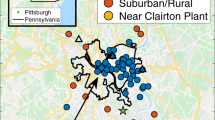Abstract
More than a dozen indoor air quality studies have reported a large discrepancy between concentrations measured by stationary indoor monitors (SIMs) and personal exposure monitors (PEMs). One possible cause of this discrepancy is a source proximity effect, in which pollutant sources close to the respondent cause elevated and highly variable exposures. This paper describes three sets of experiments in a home using real-time measurements to characterize and quantify the proximity effect relative to a fixed distant location analogous to a SIM. In the first set of experiments, using sulfur hexafluoride (SF6) as a continuously emitting tracer pollutant from a point source, measurements of pollutant concentrations were made at different distances from the source under different air exchange rates and source strengths. A second set of experiments used a continuous point source of carbon monoxide (CO) tracer pollutant and an array of high time resolution monitors to collect simultaneous concentration readings at different locations in the room. A third set of experiments measured particle count density and particle-bound polycyclic aromatic hydrocarbon (PAH) concentrations emitted from a continuous particle point source (an incense stick) using two particle counters and two PAH monitors, and included human activity periods both before and during the source emission period. Results from the SF6 and CO experiments show that while the source is emitting, a source proximity effect can be seen in the increases in the mean and median and in the variability of concentrations closest to the source, even at a distance of 2.0 m from the source under certain settings of air exchange rate and source strength. CO concentrations at locations near the source were found to be higher and more variable than the predictions of the mass balance model. For particles emitted from the incense source, a source proximity effect was evident for the fine particle sizes (0.3 to 2.5 µm) and particle-bound PAH up to at least 1.0 m from the source. Analysis of spatial and temporal patterns in the data for the three tracer pollutants reveal marked transient elevations of concentrations as seen by the monitor, referred to as “microplumes,” particularly at locations close to the source. Mixing patterns in the room show complex patterns and directional effects, as evidenced by the variable intensity of the microplume activity at different locations. By characterizing the spatial and temporal variability of pollutant concentrations in the home, the proximity effect can be quantified, leading to improved indoor monitoring designs and models of human exposure to air pollutants.
This is a preview of subscription content, access via your institution
Access options
Subscribe to this journal
Receive 6 print issues and online access
$259.00 per year
only $43.17 per issue
Buy this article
- Purchase on Springer Link
- Instant access to full article PDF
Prices may be subject to local taxes which are calculated during checkout
Similar content being viewed by others
Author information
Authors and Affiliations
Corresponding author
Rights and permissions
About this article
Cite this article
MCBRIDE, S., FERRO, A., OTT, W. et al. Investigations of the proximity effect for pollutants in the indoor environment. J Expo Sci Environ Epidemiol 9, 602–621 (1999). https://doi.org/10.1038/sj.jea.7500057
Received:
Accepted:
Published:
Issue Date:
DOI: https://doi.org/10.1038/sj.jea.7500057
Keywords
This article is cited by
-
Classroom aerosol dispersion: desk spacing and divider impacts
International Journal of Environmental Science and Technology (2022)
-
Personal CO2 cloud: laboratory measurements of metabolic CO2 inhalation zone concentration and dispersion in a typical office desk setting
Journal of Exposure Science & Environmental Epidemiology (2020)
-
Preparation and performance features of wristband samplers and considerations for chemical exposure assessment
Journal of Exposure Science & Environmental Epidemiology (2017)
-
Stochastic modeling of short-term exposure close to an air pollution source in a naturally ventilated room: An autocorrelated random walk method
Journal of Exposure Science & Environmental Epidemiology (2014)
-
Indoor/outdoor pollution level and personal inhalation exposure of polycyclic aromatic hydrocarbons through biomass fuelled cooking
Air Quality, Atmosphere & Health (2014)



